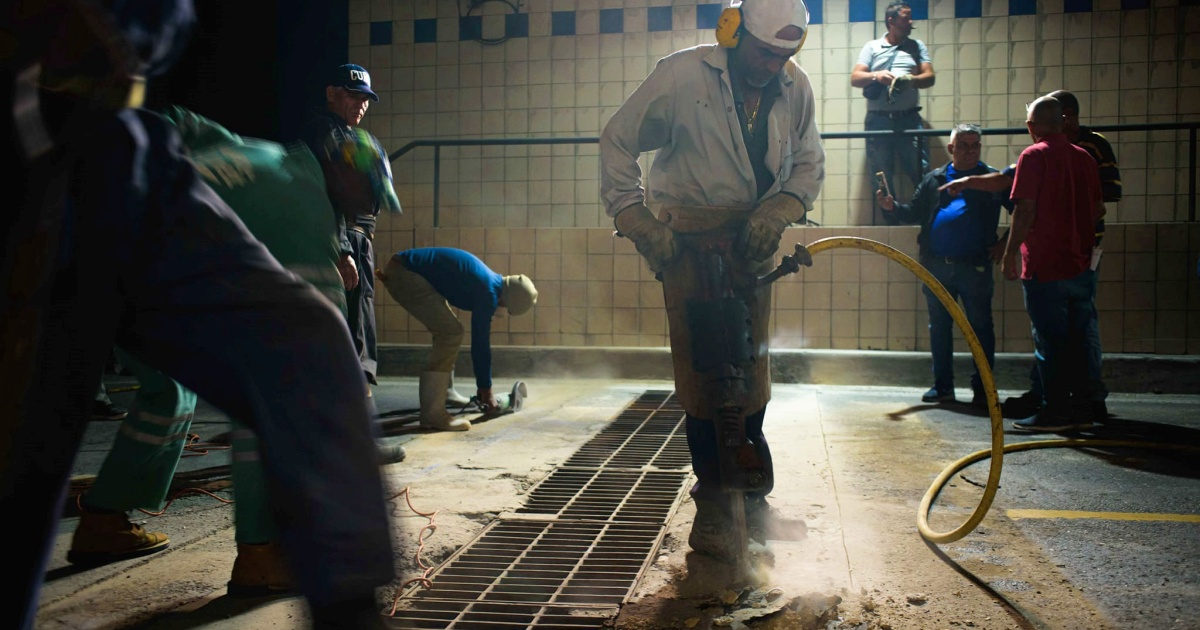
As planned, In the early morning of April 6, the La Bahía Tunnel on the Havana-Cabañas path closed with the purpose of carrying out various repairs and maintenance works, especially the replacement of the first grate, which is important for the evacuation of water.
In the last hours, the Minister of Transportation, Eduardo Rodríguez Dávila, published the first images of the interior of the tunnel during the repair, as well as details of the work being done.
“Over the years, this grille moved from its original place, which is why it was finally necessary to place a metal plate. With all the resources and construction forces at full disposal, the pavement demolition work began at 00:00 hours, to begin the replacement of the grille,” says a report from the general director of the National Road Center, Sandra. Loureiro Rodríguez.
The demolition is carried out by the Havana Road Company in conjunction with the Transport Construction company.
The aforementioned source reported that after the concrete, which supports the grid today, is demolished, the rubble will be collected, the old material will be removed, and the formwork and cleaning will be carried out to pour the concrete again that will solve the problem of the deterioration of the grille area.
Three days will be dedicated to demolition, formwork and concreting, and then seven days will wait for the first phase of concrete setting until the tunnel reopens.
However, once the tunnel is reopened, during the first days the protection plate will be placed again on the grating with the aim of protecting it until May 5, when it is estimated that the final setting of the tunnel entrance will reach.
The Ministry of Transportation reported that the National Applied Research Company of the Ministry of Construction (ENIA-INVESCONS) will be in charge of carrying out the required concrete tests that determine the resumption of vehicle traffic.
Although the replacement of the grate for water evacuation is the main purpose of the current closure of a tunnel path, other construction and maintenance tasks will be carried out:
-Patching tasks will be carried out with hot asphalt concrete to cover the visible gaps in the 700 meters of the closed path with mixture supplied by the Engineering Works Construction Company #5 of the MICONS.
-He's going to work in removing corks from roofs and cleaning their steel. Three MSMEs will work on these works: Doctamel, Cobas Construcciones and EMCONAT.
The first two MSMEs They will be in charge of repairing the fins known for being the high blue walls who welcome you as you exit the tunnel towards the toll and Morro Cabaña.
Each of the brigades will have a 12-hour work schedule. Cobas Construcciones will assume the night schedule and Doctamel will do so during the day.
-They will work on repairing the walls, where they will clean all the damaged areas. They will be treated with waterproofing materials, completed with cement, painted and given the final finish.
-Inside the tunnel, EMCONAT It will support the cleaning of the five grid batteries, the repair of the traffic lights, the cleaning of the walls and the conditioning of the tunnel lighting.
-Additionally, work will be done on horizontal signage, a task assumed by the Traffic Engineering body, belonging to the Ministry of the Interior (MININT).
Last week, the Havana Provincial Road Safety Commission announced the total closure of the Havana-Cabaña traffic of the Bahía Tunnel due to repair and maintenance actions on the important underground road and specified the road traffic organizational measures that will be adopted as a result. of the closure.
As explained then, only special traffic regime vehicles will have access to the tunnel, which means ambulances, firefighters and the police.
“Passenger transportation vehicles related to public and company transportation buses, taxi and route services, and private porters duly identified with the regular service sticker will also have access.”
The informative note He added that the rest of the drivers will be able to “use as alternative routes in their travel, to and from the east, the Vía Blanca, Ciudad Deportiva, Avenida 26, Avenida del Puerto and Anillo del Puerto.”
The announcement took place shortly after the Minister of Transportation, Eduardo Rodríguez Dávila, report on the situation of the Havana Bay Tunnel.
In an extensive post on Facebook, the head of Transportation announced upcoming maintenance actions on the pipe in the Havana-Cabaña direction, while speaking about the complaints about dripping inside the important underground road From the capital.
On this last topic, he said that studies were carried out by the National Company for Applied Research (ENIA) of MICONS, which concluded that The drip cycle seen is similar to that presented at other times in previous years.
Rodríguez Dávila added that, however, it will be intervened for waterproofing, although it is not included in the maintenance announced now because it requires conditions, materials and specialized advice. He also stressed that the drip observed “At the moment it does not represent a danger to the current structure and circulation of the tunnel.”
The Havana Bay Tunnel was built between 1957 and 1958 by the French company Société de Grand Travaux d Marseille, and was inaugurated on May 31, 1958. It connects Old Havana with the east of the city and allows the passage of about 32 thousand vehicles every day.
It has two reinforced concrete tubes, capable of supporting tons of water, its length reaches 733 meters and is made up of seven concrete sections coupled by steel joints. It was covered with stone and concrete to restore the original surface of the seabed and is located at a depth of between 12 and 14 meters.
In its more than 65 years of life, it has undergone maintenance at various times, including a capital repair in 2001, carried out by the same French company that built it.
What do you think?
COMMENTFiled in: